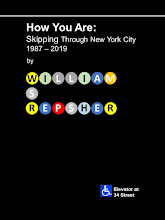After roughly six months of preparation, it's finally here: How You Are: Skipping Through New York City 1987 - 2019.
It doesn't exactly pick up where Skipping Through the Graveyard in My Puke-Stained Suit: Growing Up in 1970s Rural Pennsylvania left off. As I describe in the new book's introduction, college was such a fleeting time. "Real" college, away on my own at a campus, was only two years. An incredible two years, but I'd have a hell of time remembering half of what really happened and haven't documented all that much through the years. I did provide a chapter that glossed over my college years, but I can't really do that period of my life justice.
I can do justice for New York City. I've been here over 30 years and much as with the first book, I eventually realized I had more than enough material to piece together a book. From my first days here, I was writing, often professionally, and I kept it all. Some of the pieces in books come from personal letters and articles that never quite made it with various NYC publications. As I told a friend recently, this book is a junkyard, and if you haven't already guessed, you can build some crazy shit with the help of junkyards.
The city has changed so much in the past 30 years, radically, something that crept up on me in the early 00s. I began to realize, the place I moved to wasn't the place I was living - mainly in terms of the hyper-gentrification that kicked into higher gear around that time and hasn't let up. I'm not going to tree-stump on this issue, but if I end up leaving New York City, this will be the overwhelming reason.
You can see it in Long Island City. One of the chapters details a friend, James, turning 30, and our celebrating this in a neighborhood Long Island City bar. (This originally appeared as an article in NYPress in early 2002.) I remember being a bit on edge going down to that bar, at night. As I noted, tumbleweeds would have blown through that part of town if NYC had tumbleweeds: vacant lots, taxi-cab dispatchers, parking lots, factories, a few gas stations. It's not fair to say "nothing" was down there, but I just described about 40% of the land area.
I recall a fire at the block of buildings at Roosevelt Plaza just before this in 1999, a frightening experience seeing billowing black smoke that close to the train. That seemed to have signalled something, because just after that, the first luxuy hi-rise was constructed. Then another. Then another. Each one blocked the previous hi-rise's view of Manhattan. Not just there, on the north side of the 7 Train. A massive change started happening on the southern side. Nearly 20 years later, there are dozens of luxury hi-rises dominating the Long Island City skyline, amidst the working- and middle-class people who have lived there for decades. Every time the N Train hangs that low right turn into the Roosevelt Plaza station, I see all those massive, gleaming luxury towers that have overtaken the neighborhood. It's disheartening, to say the least, and I see it every god-damn day.
I'd be shitting bricks if I was living there; hell, I feel the pressure miles north of there in the Ditmars area of Astoria. I heaved a quiet sigh of relief when the Amazon deal was turned down in those empty trainyards in Long Island City; the already sky-high rents around here would have entered San Francisco's impossible stratosphere of overpriced real estate.
But enough of that. It's an every-day fact of life now for those of us who have lived through decades in this city, and something all of us need to pick up and keep moving with. It's like we're being chased by a wolf pack, and every few months, the pack consumes one of us. My time will surely come! Until then ...
I've done the best I can with this book to present the New York City that I know, slightly on the underside, far from down and out. At best? I hope this book invokes the spirit of The Basketball Diairies by Jim Carroll. Not the heroin. But that voice, a hard sense of working-class New York City, of neighborhoods, subways, corner bars and bodegas. I'm not Jimmy Breslin. If anything, I hope the book underlines what it's like for an average American kid to move to a place like this and make it work for him. If my sensibilities are "New York," they are in the sense of any other emigrant coming here and mixing his heritage with the reality of the city he comes to understand.
So, have at it, if you're interested, buy a copy, I'd surely appreciate it. I wish I could dedicate more time to the blog, but I've been working my ass off the past few months to make this happen, and that took over all my spare time. If and when I do get back into this, I'll surely shoot for shorter passages. Thank God I kept this blog going, as it's provided roughly half of each of my last two books. I knew it all meant something; it was just a matter of learning how to present it. I'd like to keep this going, but let me think about how I can do it. In the meantime, let me steal your money ...
Sunday, October 27, 2019
Subscribe to:
Posts (Atom)


